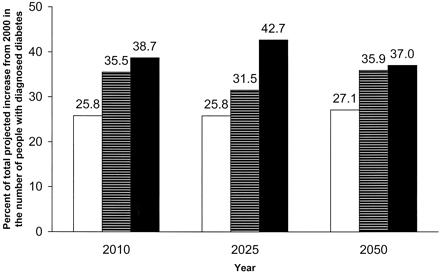Growing Diabetes in Adolescents
Diabetes has taken control over 26.9 million Americans (CDC, 2020). Adolescents from 10 to 19 should maintain a healthy diet such as fruits and vegetables and a healthy lifestyle, like sports or workouts. A high prevalence in adolescents of 25 to 10,000 Americans is diagnosed with diabetes which will continue to raise the percentage of diabetes in the population. Some of the causes of diabetes are failure to eat healthy and hereditary passing of diabetes.
Percent of Total Increase the number of people with diagnosed diabetes in 2000
DID YOU KNOW?
-
Approximately 9.4% of Americans (30.3 million) had diabetes in 2015, in comparison to 11.2% of Texans (2.3 million)(Robinson,2018).
-
In Texas, we’re at a whopping 10.9 percent. In Tarrant County, the number is 11.3 percent (Mcguire, 2016).

From: Reprinted from Diabetes Care. (2001). American Diabetes Association
The bar graph showed the percentage breakdowns of the projected increase in the total number of people diagnosed with diabetes due to population growth, increasing prevalence rates, and demographic changes.
Why do adolescents need to be careful about diabetes?
-
The Saudi Abnormal Glucose Metabolism and Diabetes Impact Study (SAUDI-DM) evaluated the prevalence of type 1, type 2 diabetes, and prediabetes in children and adolescents (Al-Rubeaan, 2015). They collected clinical data from nationwide households by randomly selecting 23,523 children and adolescents aged 18 years and younger.
-
They classified the participants with diabetes according to their type of diabetes. In contrast, participants without diabetes were assessed for glucose level when hunger and they used the American Diabetes Association (ADA) criteria to identify patients with diabetes.
-
A lipid lab test screened all studied participants to analyze and assess different risk factors.
-
The overall prevalence of diabetes was 10.84%, which is 0.45% of type 1 and type 2 patients with diabetes and 10.39% of either newly diagnosed cases of diabetes (4.27%) or prediabetes (6.12%).
-
More than 90% of the participants have diabetes but are unaware of their condition.
-
FYI: The overall prevalence of diabetes cases was more significant than the cases reported internationally. Age, male gender, obesity, urban residency, high family income, and the presence of abnormal elevated cholesterol or fats in the blood condition were significant risk factors for diabetes and prediabetes.
DID YOU KNOW?
-
In 2020, Texas diabetes rate in females was 11.5%, while the male is 13.0% (America’s Health Rankings, 2019).
From: Texas Health Data, 2020. Behavioral Risk Factor Surveillance System (BRFSS).
Do not be afraid if you have diabetes
National Support
-
The U.S has three federal laws addressing the school’s role in helping students with diabetes (National Institute and Digestive and Kidney Diseases, 2021).
-
Section 504 of the Rehabilitation Act of 1973
-
Americans with Disabilities Act of 1990
-
Individuals with Disabilities Education Act.
-
The Family Educational Rights and Privacy Act also protect the student’s privacy.
-
These federal laws support a framework for planning and implementing effective diabetes management in the school setting, preparing the student’s education plan, and ensuring that the student has access to appropriate care.
Texas Support
-
House Bill amended the Texas Health and Safety Code by adding Chapter 168 related to caring for students with diabetes in the school setting (Texas Diabetes Council, 2020).
-
The Texas Diabetes Council developed Care of Elementary and Secondary School Students with Diabetes guidelines for training Unlicensed School Employees to serve as Diabetes Care Assistants (UDCA).
-
A UDCA is a trained volunteer that helps students with their diabetes management, and the school principal is the one who supervises them.
-
To assist the students with diabetes in the school, Health and Safety Code requires that the school principal seek school employees who are not health care professionals to serve as UDCAs care for students with diabetes.
-
The school district must provide each district employee responsible for providing transportation for a student with diabetes or supervising a student with diabetes during an off-campus activity. Notably, the school must permit the diabetes students to attend their care outlined in the individual health plan.
From: Texas Health Data, 2020. Behavioral Risk Factor Surveillance System (BRFSS).
What should you do?
Take the Signs and Symptoms of Diabetes quiz below if you’re concerned about the possibility of diabetes in either themselves or a loved one. Parents can take the examination for their children. At the end of the quiz, the result will assess the risk of having diabetes.
https://www.proprofs.com/quiz-school/story.php?title=signs-and-symptoms-of-diabetes
From: Megmckernan. (2013). ProProfsQuizzes
References
Al-Rubeaan, K. (2015). National surveillance for type 1, type 2 diabetes and prediabetes among children and adolescents: A
population-based study (SAUDI-DM). PubMed. https://pubmed.ncbi.nlm.nih.gov/26085648/
America’s Health Rankings. (2019). Explore Diabetes in Texas | 2020 Annual Report.
https://www.americashealthrankings.org/explore/annual/measure/Diabetes/state/TX
Centers for Disease Control and Prevention. (2020). Prevalence of Diagnosed Diabetes.
https://www.cdc.gov/diabetes/data/statistics-report/diagnosed-diabetes.html
Mcguire, D. M.D (2016). Protecting teens and young adults from type 2 diabetes.https://utswmed.org/medblog/teens-type-2-diabetes/
Megmckernan. (2013). Signs And Symptoms Of Diabetes. ProProfs. https://www.proprofs.com/quiz-school/story.php?title=signs-and-
symptoms-of-diabetes
National Institute and Digestive and Kidney Diseases. (2021, November 3). Helping the Student with Diabetes Succeed. National
Institute of Diabetes and Digestive and Kidney
student-diabetes-succeed-guide-school-personnel
Robinson, S et,.(2018). Diabetes in Texas
https://demographics.texas.gov/Resources/publications/2018/2018_12_17_DiabetesProfile.pdf
Texas Diabetes Council. (2020). Guidelines for training school employees - Texas. Texas Department of State Health
Services. https://www.dshs.texas.gov/txdiabetes/PDF/GuidelinesForUDCATraining.pdf.
Texas Health Data - Behavioral Risk Factor Surveillance System (BRFSS). (2020). Behavioral Risk Factor Surveillance System
(BRFSS) [Data set]. https://healthdata.dshs.texas.gov/dashboard/surveys-and-profiles/behavioral-risk-factor-surveillance-system